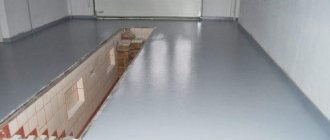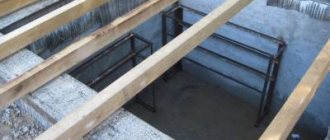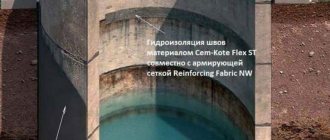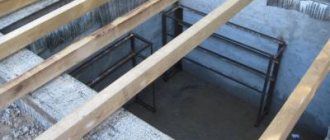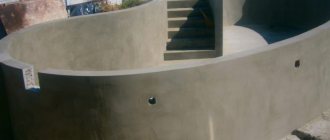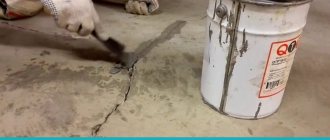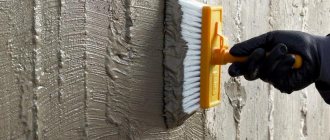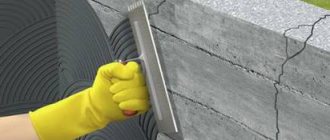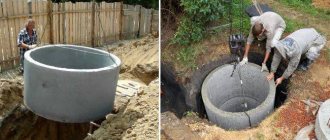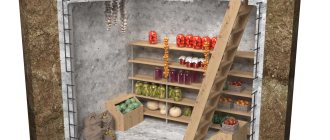Home» Construction and design» Foundation» Waterproofing the basement from the inside with liquid glass
- Text updated: 10/17/2016
The need for waterproofing the basement is obvious. Otherwise, dampness and its accompanying factors (rot, mold, mildew, corrosion) will destroy the foundation itself and penetrate through the capillaries into the house. The result is irreversible damage to load-bearing structures and finishing materials, a reduction in the service life of all elements of the house, a painful microclimate, and cold.
One of the popular methods of protective treatment of the base is waterproofing the basement from the inside with liquid glass.
This technology has many advantages: low cost, low material consumption, ease of application. Processing takes a little time.
Liquid glass is almost universal. Used primarily for porous concrete surfaces, but also suitable for metal and wooden structures. It is absorbed into cracks and pores, penetrates deeply, forms a durable crystalline layer on the outside and completely fills the voids.
note
The only requirement is strict adherence to proportions and processing technology. Otherwise, instead of strength, you can get fragility.
What kind of liquid glass is there for basement waterproofing?
Based on their chemical composition, sodium glass (sodium silicate) and potassium glass are distinguished.
The peculiarity of sodium is its good adhesiveness and the ability to interact chemically with minerals. This material is often used to strengthen load-bearing structures and in the manufacture of antiseptics and fire retardants.
Potassium (otherwise called ceramic liquid thermal insulation) is characterized by resistance to acids and high weather resistance. Frequently used as an additive in the manufacture of paints and varnishes.
Waterproofing with liquid glass closes the pores of concrete, reduces moisture absorption, increases abrasion resistance, and creates chemical protection.
Prevents the appearance of biological products of dampness - mold, mildew, rot, improves fire resistance, increases impact resistance.
Purpose and application
In industrial production, liquid glass is produced by firing soda and quartz sand or autoclave treatment of silica-containing raw materials with alkalis. The compound is then crushed, mixed with modifiers and dissolved in water. The chemical composition is a mixture of sodium, potassium or lithium silicates.
- Sodium liquid glass is used for the production of fire-resistant bricks, non-flammable impregnations for wood and fabrics, antiseptics, construction adhesives and waterproofing compounds.
- Glass based on potassium silicate is used for the manufacture of varnishes, paints, acid-resistant concrete and solutions.
- Lithium liquid glass has found application in sealing impregnation of electrodes and concrete floors before polishing.
The most commonly used glass composition in construction is sodium and potassium silicate.
Two methods are used to protect the surface of concrete structures from moisture:
- external application;
- introduction to the composition of the material.
When applied to the surface of concrete, liquid silicates penetrate into the pores and capillaries. As a result of interaction with cement components, substances crystallize. Water-insoluble compounds are formed that prevent moisture from filtering through the outer layer of the material. The treated coating has hydrophobic - water-repellent - properties, resistance to elevated temperatures, and aggressive acids.
A solution of silicate glue with modifying additives is used for surface treatment of structures in the form of paint or plaster insulation. The penetration of water through the protective barrier stops, and the frost resistance and chemical stability of the material increases.
Technology for waterproofing basements with liquid glass
There are two main ways to use glass to create a water barrier.
In the process of preparing for waterproofing, the concrete surface is cleaned of dirt, degreased, and leveled with plaster mortar. Next, it is treated with liquid glass using a spray gun, brush or roller.
Concentrated glass is diluted with water in a ratio of one to two. The consumption usually ranges from 150 to 300 grams per square, depending on the quality of the base.
The depth of penetration of insulation into the pores when applied in one layer is one to two millimeters. For deep impregnation, you need to apply several layers of the composition, in this case the penetration will be up to two centimeters. When processing, special attention is paid to seams and joints.
The second processing method is to use glass in the concrete solution, one to ten.
Such waterproofing is sufficient for basements, plinths and even for water tanks - ponds, swimming pools. The technology is used to repair serious leaks and can be used on prefabricated foundations of wooden houses. The proportions must be observed carefully to avoid the fragility of the layer, and take into account that the composition dries quickly.
Such waterproofing can be combined with traditional bitumen. The concrete is impregnated with the composition, then the rolled material is placed. It is recommended to apply the glass twice to ensure that the pores are filled.
There is another option, not used often. Treatment with liquid glass of wooden parts of the foundation (for example, pillars) or boards of the internal lining of the basement. The element, previously sanded with emery cloth, is immersed in a solution of liquid glass.
The composition can also be used for anti-corrosion protection of metals - coat pipes with it.
For the processing method described below, you need to purchase soda glass. You will also need tar solution and clay. Procedure:
1. Treat the walls with glass in three layers.
note
Before applying a new layer, you should wait until the previous one has completely dried. Drying usually takes 15 minutes, but this depends on the temperature and humidity in the room.
2. Dilute the clay in water, mix with a concentrated solution of tar until the consistency of thick sour cream.
3. Treat the walls with a layer of 25 centimeters.
4. Dry for two weeks and finish. Before tiling the surface, you need to wait three weeks.
Areas of application
Liquid glass is used in three areas:
- Waterproofing of floors and walls of underground structures: well, swimming pool, basement, etc.
- As an additive when preparing plaster for facades and rooms with high humidity, such as a swimming pool or well. But it should be borne in mind that such a solution hardens very quickly and must be produced immediately. But such walls do not require additional waterproofing.
- Liquid glass can also be used as a modifier additive for concrete, after which it becomes a heavy-duty monolith with water-repellent characteristics. In this case, you must strictly adhere to the proportions (depending on the brand of cement), otherwise you can change the quality of the concrete so much that it itself will become as fragile as glass.
Recommendations for using plaster with glass
- The penetrating compound should be applied to wet concrete. If it has just been poured, there is no need to wait for complete setting; for horizontal waterproofing, strip aluminum and lead should not be used; for structures subject to serious shrinkage, plaster with liquid glass is not recommended; the mixture must be prepared in small parts, since it hardens quickly; in hard-to-reach areas In some places, the composition is simply poured into the cracks and the excess is removed with a brush.
When working with glass, you need to ensure that the basement is well ventilated, and also use universal protective equipment, including a respirator. You need to wear gloves when working; if the composition gets on your skin, wash it off immediately. The material is non-toxic, but can cause inflammatory processes in the skin and mucous membranes.
- Tags: basement waterproofing, liquid glass
Moisture penetration through the foundation walls of basement rooms is a direct threat to the normal functioning of the house.
Everyone knows the expression that “water wears away stones.” Waterproofing protects the basement from groundwater, thereby protecting it from dampness and slow destruction and shrinkage. One of the affordable and effective methods is to cover surfaces from the inside of a building with liquid glass.
Table of contents:
Pros and cons of concrete mortars with silicate additives
Liquid glass improves the quality of concrete.
The modern building materials market offers a wide range of various composite compositions used as improving additives in cement mortars.
However, the popularity of such time-tested material as liquid glass does not decrease. This is due to its ease of use and fairly low cost compared to other artificial additives for concrete mixtures.
By mixing liquid glass with cement, you can get concrete solutions that are used in the following construction work:
- During the construction of concrete foundations of buildings, walls of wells, sewers and other structures that are supposed to be operated in conditions of high humidity.
- When pouring a concrete screed, when it is required to give it additional waterproofing and strength properties.
- When plastering surfaces exposed to significant heat - fireplaces, stoves, etc.
You need to be able to work quickly with liquid glass.
Among the advantages of cement compositions with liquid glass are:
- High level of adhesion to any surfaces.
- Excellent waterproofing properties due to the ability of the silicate solution to fill all pores in concrete.
- Increased strength, which is achieved by introducing silicate solutions into the concrete composition.
Like all other building materials, liquid glass with cement also has its disadvantages. First of all, this is the rapid crystallization and solidification of the solution, as a result of which the time of its use is limited.
However, in some cases this can be a big plus. The table shows the setting ratio of cement mortar depending on the percentage of liquid glass in its composition.
| Percentage of liquid silicate | Start of setting, min | Complete drying time, h |
| 0 | 60 | At least 7 days |
| 2 | 40 | 24 |
| 5 | 30 | 16 |
| 8 | 15 | 8 |
| 10 | 5-7 | 4 |
Concrete mixed with silicate composition cannot be used for the construction of load-bearing structures.
The more you add this mixture to concrete, the more brittle it can become.
The fact is that as the proportion of silicates increases, the strength of concrete first increases, but then decreases significantly. So, if you mix liquid glass and cement, then after a week such a solution will be 1/3 stronger than concrete without silicate additives.
However, after a couple of weeks, the strength of the silicate-cement mortar begins to fall, and by the end of the month from the day of pouring it is already 25% inferior in strength to pure concrete. And the higher the proportion of glass in the proportion of the mixture, the more fragile the concrete becomes by the end of its complete drying.
Reasons for moisture penetration in the cellar
1. The first, external waterproofing, was done incorrectly or its integrity was compromised. If there is a high level of water in the ground or a large amount of precipitation, a drainage system must be installed.
2. Changes in the occurrence of groundwater levels.
This happens due to natural processes. Another reason is due to the fact that structures were erected nearby that disrupted the previously existing balance of circulation. For example, a neighbor built a swimming pool and installed a drainage system that did not comply with the rules.
3. Shrinkage of the building, which leads to the formation of cracks and damage to the external insulation.
Making protection in an already built house is a complex and time-consuming process. The optimal solution is to use impregnation with liquid glass, rubber, or penetrating mixtures.
Advantages of waterproofing material
Brick, plasters, and concrete of various brands are a durable but porous composition.
With constant moisture pressure, a capillary suction effect occurs. Water penetrates them from the inside, rises to the top and gradually the wall becomes wet. Liquid glass is intended specifically for these types of surfaces; it is also used for wood, but a different application method is used.
Liquid glass is silicates (silica material) based on aqueous-alkaline solutions. There are two types: potassium and sodium. In the process, they fill micropores and crystallize, thereby creating an insurmountable barrier in the form of a film.
Advantages:
- The application process is simple, so you can easily carry out the insulation yourself. In concrete-cement structures, which in the vast majority of cases are used to make cellars, basements and basement floors, metal is used as a reinforcing base. The composition protects against corrosion. Acts as an antiseptic, preventing the formation of mold and mildew. The glass film is resistant to ultraviolet radiation and chemically aggressive environments. The material is highly reliable in terms of water penetration into the room. Used as protection for the decorative layer.
The disadvantages are that it is difficult to apply paint and finishes on top as it reduces surface adhesion. When applied to a damp base, waterproofing glass will not be absorbed, which is why the room must be thoroughly dried naturally or using heat guns before treatment.
You cannot dilute the composition in larger proportions than indicated in the instructions, even if it thickens.
Use in small batches as it hardens quickly. If you apply a thick layer, cracks may appear on it. Brick, plaster, and concrete should be coated in an amount that the surface can absorb.
Foundation waterproofing
Waterproofing the foundation with liquid glass is one of the common methods of protecting a structure from moisture. There are several options for using a mixture of Na and K silicates for foundation waterproofing:
- Coating waterproofing with an aqueous solution of the composition. With this method, the mixture is spread several times directly onto the concrete, which will subsequently be protected by roll insulators.
- To construct a waterproofing layer, a mixture of concrete and liquid glass (10:1) is used. It is worth considering that this mixture hardens very quickly, so it is recommended to use it to eliminate leaks and seal seams.
- The use of liquid glass as an additive to the concrete mixture when pouring the foundation directly. Here it is very important not to miscalculate the correct proportions, otherwise the foundation of the house may end up with a low margin of safety.
Liquid glass for waterproofing must be clean - a solution of a homogeneous structure without lumps or impurities. Application of liquid glass for waterproofing concrete according to the instructions is as follows:
- The foundation is being prepared for applying a layer of liquid glass. To do this, the surface of the monolith should be thoroughly cleaned of dirt and dust.
- For the first time, the silicate mixture is spread on the base in the most convenient way.
- After an hour of waiting, a second layer of liquid glass is applied to the concrete. At this stage, it is important to ensure that there are no gaps left when applying the second layer.
- The final coating of a mixture of glass and cement is being prepared. To do this, mix the ingredients in a wide container at a ratio of 1:1. The composition must be applied quickly, as the solution hardens, and repeated mixing is unacceptable.
- When the waterproofing cake is dry, you can begin other work.
From the above it follows that the application of liquid glass is not much different from the coating waterproofing of the foundation. The procedure does not require any specific skills and all work on moisture protection of a concrete foundation with liquid glass can be done with your own hands.
Rules of application
The most vulnerable places where water leaks:
- joints of slabs, seams; microcracks; installation sites; wells in which the pump is installed.
Waterproofing with liquid glass is one of the modern methods of preventing the penetration of moisture from the inside into the cellar, as is the use of liquid rubber. Coating, unlike penetrating, often cannot withstand hydraulic pressure and peels off. Complete protection is achieved when coating materials on the outside are combined with penetrating materials on the inside.
The following steps need to be taken:
Find places where moisture is seeping in and try to expand them in order to treat more deeply and thoroughly. Examine the blind area. If a violation of the integrity of the structure is detected, then they need to be concreted. An important drawback is the lack of ventilation.
In this case, the moisture does not evaporate. It is necessary to make a ventilation outlet. When erecting a building, pay attention to insulating the foundation from the outside. A warm wall outside significantly reduces the formation of condensation.
Areas of use
There are several ways to use this material:
- coating;
- penetrating;
- additive to a monolithic foundation.
Coating waterproofing is used in cases where it is necessary to create particularly effective protection. When waterproofing a foundation, liquid glass is usually used as a preliminary layer before roll insulation. It is enough to apply 2 layers of liquid glass to the concrete surface with a brush, and sealing will be ensured.
The penetrating method is used when it is difficult to reach the surface being treated.
How to properly apply a waterproofing compound yourself?
Prepare protective equipment, gloves, maybe a gauze mask, and overalls.
You can apply it using: paint brushes, paint brushes, rollers, spray guns. The material is sold in liquid or powder form. The instructions indicate the proportions of dilution with water; failure to comply with this rule will provoke technical deficiencies in the protective layer.
The surfaces are dried and the cracks are widened. It is better to prime the walls with deep penetration mixtures.
First, they lay it on joints, cracks, and then prime the rest of the surface. Depending on the humidity of the room, allow it to soak in and dry for 4 hours. If the building is poorly ventilated, it may take longer to dry.
Dilute the solution in the required proportions and apply it to problem areas through which moisture seeps.
Then they cover the walls, floor, and, if necessary, the ceiling. On average, waterproofing penetrates to a depth of 2 mm with one layer. The material from which the basement is made has excellent humidity in different places and unequal porosity.
This will immediately become visible after the composition is absorbed into the surface. Where the protective layer has formed, a characteristic protective film with a glossy sheen appears. It is more effective to make several layers - this ensures deeper penetration.
Drying time varies depending on the type of surface and room humidity: from 40 minutes to 12 hours or more. It is better to immerse wooden structures in silica mixtures.
Silicate composition is a universal remedy not only for treating cellars, but also for waterproofing wells; it is introduced into cement mortars.
- Date: 10-08-2015 Rating: 20
Today, various methods and materials are used for waterproofing work; they differ not only in their properties, but also in cost and application technology.
Internal waterproofing with liquid glass is considered a modern option for protecting buildings from groundwater. Mixtures based on this material are applied to interior walls. As a result, a very durable layer is created on the surface; crystals penetrate into all pores, providing one hundred percent protection.
Basement arrangement.
The work process to protect the cellar from moisture and condensation is not very complicated; you just need to make the solution correctly in accordance with all the manufacturer’s requirements.
It is worth remembering that the application time is reduced, you need to work as quickly as possible. Some experts recommend mixing the solution in small parts so that the composition can be applied within half an hour or an hour. It all depends on external conditions, for example, air temperature.
Table of characteristics of liquid glass.
Protecting the basement from the inside with liquid glass has its advantages:
Increasing the hardness of surfaces is achieved by crystallizing the composition, its penetration into the material, filling all its pores. This allows you to increase resistance to abrasion and mechanical stress.
No other waterproofing material has such properties. Moisture absorption by internal structures is minimized. This provides the highest level of protection, which increases the service life of basement structures and the building itself. If there is a need to protect the decorative layer, then liquid glass acts as the optimal material. It not only allows you to preserve all the properties of the coating, but also improves its characteristics and resistance to various influences.
The liquid glass itself must be diluted with plain water before use.
The ratio must be 1:2. The average material consumption is 150-300 g per 1 m², but it all depends on the quality of the surface, its material, and external working conditions. After impregnation with liquid glass, an unusual, but very durable and hard coating remains on the surface, which is resistant to moisture, loads, and shocks.
Provides protection against mold, mildew and microorganisms. Today, this kind of material can be considered the highest quality, optimal for working not only with basements, but also in bathrooms, cellars, and premises of a residential building. The use is extremely simple, the cost of insulation is reasonable.
Return to contents
Basement waterproofing with liquid glass.
The use of liquid glass for waterproofing requires compliance with certain conditions:
Liquid glass is applied to the interior walls, the surface is carefully leveled, and then degreased. To superficially impregnate all concrete or the internal plaster layer, use a brush or a special spray gun.
Liquid glass will penetrate the surface of the walls to a depth of 1-2 mm. If deep impregnation is required, several layers of liquid glass are applied. The composition can penetrate to a depth of 20 mm. If part of the internal structure of the basement is made of wood, then the treatment is carried out differently.
Protection from moisture is achieved by placing the surface element directly into a special container with liquid glass. But this method is rarely used; it can only be used for a columnar foundation or when constructing wooden columns or the internal lining of a cellar. Using this composition, not only waterproofing the basement from the inside is carried out, but also other types of work. The composition has anti-corrosion properties.
If there are pipes in the room, you can quickly and easily provide them with long-term protection. This is important not only for basements, but also for cellars where food is stored, since the negative impact of moisture is most pronounced here. In this case, the most reliable protection is created; all treated surfaces seem to be covered with a thin but durable crust, which is resistant to many types of influences.
Return to contents
It should be remembered that before applying liquid glass, the surface must be cleaned of dust and dirt.
The main steps in how to protect a basement using liquid glass are as follows:
First you need to mix the liquid glass itself.
To do this, use a brush, brush or rollers. But the cooking recipe will largely depend on what the glass will be used for. The characteristics must be indicated by the manufacturer on the packaging; you just need to familiarize yourself with them, and then start mixing the waterproofing solution. The surface must be completely cleaned of dust, dirt, mold, and traces of fungus before treatment.
If the composition is applied to the wooden surface of the basement (rarely, but such structures are used in the construction of a house), then it must be carefully treated with sandpaper. This will allow you to get a perfectly flat surface that is acceptable for work. Waterproofing a basement is a responsible matter, so each stage must be followed exactly. It is necessary to add a cement-based solution to the liquid glass, then mix everything until a homogeneous mortar is obtained.
It will perfectly protect the structure from moisture after crystallization. The solution is applied simply, and the work usually does not take much time. After processing is completed, all tools and hands must be thoroughly washed. Glass is not toxic, but if it gets on your skin, you should quickly wash it off with warm water.
Return to contents
Waterproofing the foundation with liquid glass.
Liquid glass is used quite often for waterproofing basements. It is supplied in convenient buckets, mixed with concrete composition, the proportion is 1:10. If the resulting mixture has become homogeneous, it can be used for waterproofing work.
The composition serves as an excellent insulating layer for concrete or reinforced concrete structures. Before preparing the mixture for work, it is necessary to take into account that liquid glass sets quickly, so processing must be carried out as accurately as possible.
Depending on the external temperature, the time required for setting varies, on average it is from 30 minutes to 1 hour.
You must first read the instructions provided by the manufacturer. The process is reminiscent of silicatization, the effect of the mixture itself is similar. Processing is not considered too difficult, but requires attention and speed, otherwise the quality of the surface will be extremely poor and the waterproofing will not perform its functions.
This type of basement waterproofing from the inside has another positive property. When the glass composition is applied, it completely fills all pores and cracks, creating an incredibly durable surface.
During operation, crystal growth is activated; the entire accessible space of the protected material is completely covered with liquid glass. The entire treated surface of the basement structure is covered with such crystals, resulting in an insurmountable obstacle to the penetration of water. The insulation is also resistant to the negative influence of air.
Modern internal basement waterproofing must meet a number of requirements.
First of all, this is a high degree of protection, simple insulation work, saving not only financial costs, but also time. A special mixture called liquid glass meets these criteria. Preparing and applying the solution to the internal surfaces of the basement structure is extremely simple; it does not require much time, and no special experience is required.
Waterproofing the cellar should be given attention at the construction stage.
How often do paradoxical situations occur in your life? At first glance - quite rare. But this is only at first glance.
The presence of a cellar in a house promises many advantages to its owners. Moisture and water themselves are the source of life. But how much do we need such an unauthorized “source” in our cellar?
A cellar in which there is water or moisture reigns cannot be called a useful and pleasant room. But here is an example of a paradoxical situation when two independent positive aspects together give a negative effect. But we can overcome moisture and dampness in the basement.
Moreover, not only for professionals. Anyone who knows how to use a paint brush, putty knife or power tool can waterproof their basement. But provided that the technology and sequence of simple operations are followed, of course.
Basic information
What it is
Liquid glass is a silicate adhesive. Its base is an aqueous solution of sodium or potassium silicate alkalis. Lithium silicate is used much less frequently - this material is used for electrode coating. In Russia, quite often, liquid glass means polishes and protective compounds for cars, which is not entirely correct. They have a completely different composition, and the confusion is caused by the fact that car products in Asia are called “glass coat”, and this translates as “glass coating”, but definitely not liquid glass. It is obtained by burning quartz sand or soda. Another method of treating silicon dioxide with alkali is to use. When solidified, a homogeneous viscous substance will become solid and will not allow water or air to pass through. Until the composition dries, it easily gets into the pores, and a protective coating is built on it. Liquid glass perfectly protects against moisture, is a hardener, antiseptic, acid protectant and increases fire resistance.
Main pros and cons
Liquid glass is quite often used for waterproofing work. This is due to a huge number of advantages:
Excellent water-repellent properties, the film is solid, because moisture will have no access to the foundation.- Liquid glass penetrates perfectly into cracks and pores and has a high degree of adhesion to the base.
- Low consumption, in particular when adding the product to a cement solution.
- Low cost compared to other waterproofing materials.
- The substance can be used at high humidity levels.
- Excellent durability. Liquid glass will last at least 5 years, and if you cover it with paint and varnish, even longer. Without additional protection, it can gradually self-destruct.
- The material gives resistance to fire, alkalis, acids, mold, and also increases the strength of the foundation.
But still there are certain disadvantages:
- Limited scope. The material goes well only with wood and concrete. This waterproofing cannot be applied to a brick - it begins to destroy the material. When they talk about the versatility of waterproofing, the composition can be used to make coating-type waterproofing and add it to concrete, while different concentrations in the solution make it possible to obtain different characteristics.
- The waterproofing is a little fragile and becomes so after hardening. To prevent the layer from being damaged, it must be additionally protected from above with other materials.
- It is almost impossible to apply a finishing finish over waterproofing - varnishes and paints do not stick to it at all.
- It is extremely important to maintain all proportions when adding glass to a cement solution, as it can harden very quickly.
- Although the installation process cannot be called specific, and no special tools are required, certain skills will still be required. You can do all the work yourself only if you have experience in improvement. You will need to work extremely quickly, because the material begins to set almost immediately.
In one case or another, the material has been used in the construction industry for more than two hundred years. During this time, people were able to come up with other materials for waterproofing, but this material is still unrivaled. The use of liquid glass for waterproofing the foundation is possible, but not in its pure form - only in conjunction with other materials, but only due to this it is possible to achieve excellent results and fully protect concrete and wood from moisture.
Area of use
Essentially, the material can be used in three main cases:
- The composition is applied to the concrete surface, dries and creates a moisture-resistant film, closing all pores. Often the material is applied in a couple of layers.
- The product is added to the concrete solution. A concrete structure created in this way receives improved waterproofing properties, but at the same time hardens much faster.
- As an additive for creating various concrete grades.
To convince you of the practicality and versatility of such a material for waterproofing, here are the most popular areas where liquid waterproofing is used:
- Foundation coating, treatment of ceilings, walls and basements.
- Waterproofing of wells and swimming pools.
- Waterproofing for wood.
- Added to concrete to improve water repellency.
- Protection of tree trunks after cutting.
- To combat mold.
- For protection against corrosive effects.
- To protect seams between building materials.
- Much less frequently, the composition is used to remove dust from concrete, and also as a quick-drying substance. It is still rarely used to create bactericidal grouts and as a sealant.
Next, let's talk about the types of material.
Types of liquid glass
The base of liquid waterproofing, as mentioned earlier, can be sodium/potassium silicate. In general, both products are very similar, but there are still certain differences:
- Potassium silicate is resistant to acids, which are distinguished by their adhesive properties and lack of glass luster.
- Sodium silicate has the same high performance properties, but it does not have the characteristic shine.
Liquid glass is sold in containers from 0.5 to 10 liters. Be sure to look for information about the manufacturer and composition. Also on the packaging there must be information that the waterproofing is made in accordance with GOST 13078-81. Less common, but there is granulated glass, which, according to the instructions, must be diluted with a certain amount of water before use.
Methods of application
Naturally, liquid glass is used for waterproofing, but it can be applied in different ways - everything will depend on the goals:
The coating method involves applying pure liquid waterproofing to the surface. As a rule, sodium silicate is used. The method is suitable for covering substrates that can generate dust and are also loose and porous. The insulating layer dries within ½-1 hour, and then a new layer can be applied. On top you can use additional material for waterproofing, for example, roofing felt.- The penetrating method of waterproofing the foundation with liquid glass has much in common with the coating method, however, it is mixed with water, and in certain cases with a dry construction mixture. This composition can be used to treat hard-to-reach surfaces, although you will need to work extremely quickly.
- By adding liquid insulation to concrete, a material that is more resistant and resistant to moisture is obtained, but this technique should be given a separate section.
Let's consider the features of using the material to improve concrete.
Sources of water and moisture penetration
Where can water get into the basement? There can be many sources and reasons.
Water penetrates through cracks, microcracks and pores. For example, reinforced concrete allows moisture to pass through micropores that remain when it sets. Water came out through these pores as the concrete gained strength.
Microcracks can also form in a brick wall, or rather in masonry mortar. Settlement of the building or depressions from fastening materials also compromise the integrity of the basement walls.
And if the walls in the cellar have a layer of lime plaster, then the lime itself attracts and retains moisture. There is no need to talk about groundwater levels or seasonal floods at all. This always posed a threat to the “golden” reserves in the cellar and had a detrimental effect on shelving and electrical wiring.
Such a small crack is enough to ruin the entire cellar.
What can be done or waterproofing options
Cellar waterproofing is a complex of drainage works. They can be divided into two blocks:
waterproofing basement walls outside the house. It is advisable to carry out these works during the construction stage.
Then any type of moisture control, be it bitumen mastic, plastering with water-repellent solutions, laying roofing felt or other rolled or sheet material, will act as a shield. Streams of water will press this shield against the wall and, resting against it, roll down; External waterproofing of basement walls. isolate the walls and floor of the cellar from the inside from any moisture.
Simple cement plaster will not give the desired result. Masses of underground water will try to tear it away from the wall. This requires special mixtures and techniques. Internal waterproofing of the basement can be done at any stage.
Important! Waterproofing is only effective when, as a result of work, an additional protective layer appears on all surfaces of the cellar. The solidity of the shell made of polymer materials creates conditions for a normal climate in the cellar.
How to use glass
How to use glass:
- First, an insulating composition is made by combining glass with cement mortar in a ratio of 1:10.
- The finished composition is used for insulation work in sanitary departments, reservoirs, wells, etc. It can also be used for insulation work with a protective system against ground moisture ingress, by impregnating reinforced concrete parts with the prepared mixture. Do not forget that the mixture sets and hardens quickly, depending on the ambient temperature, the setting period is 1-30 minutes.
- Treatment with a liquid glass composition is carried out in the same way as silicatization. This type of protection allows you to increase the service life of the building many times over. The work itself is not labor-intensive and does not require a lot of effort and money.
Surface preparation
If external waterproofing is for some reason impossible or postponed until a certain point, then you can limit yourself to waterproofing the basement or cellar from the inside. But only at first. If frequent precipitation and changing groundwater levels are very common in your area, then waterproofing work should be carried out only in conjunction with external drainage and ventilation.
It is better to start interior work in warm weather and dry weather. You need to carefully examine the walls and floor of the cellar.
Mark leak locations with chalk or marker. It is advisable to remove the old plaster completely. Otherwise, nothing and no one can guarantee the quality of work and the effectiveness of combating penetrating moisture.
You should also cut all seams to a depth of approximately 50 - 60 mm. If there are cracks or depressions from anchors in the surface of the walls, then they need to be expanded or drilled out.
Carefully examine and use a puncher, if necessary, to open the junction of the walls and floor. The penetration of groundwater begins in this place. If there are signs of mold or mildew, these areas should be thoroughly cleaned!
It is very important to thoroughly clean the walls before waterproofing.
Features of application
The feasibility of its use is explained by the following characteristics:
- The ability to apply complex configurations to structures and penetrate into any hard-to-reach places.
- The ability to form a seamless seamless coating , which guarantees 100% protection against moisture infiltration.
- High resistance to constantly damp environments, compared to bituminous materials.
- A thin, light layer of liquid glass can replace several layers of heavy roll waterproofing.
- Liquid glass is safe, non-toxic, non-flammable, and does not melt at high temperatures.
It should also be noted that waterproofing concrete with liquid glass has a positive effect on concrete grades . And the injection of this waterproofing material, coupled with cement, strengthens the foundation for the future building and protects the entire building structure from subsidence.
Let's figure it out, what is the peculiarity of this material?
Advantages and disadvantages
Liquid glass, used as waterproofing, is a thick, viscous and sticky mixture of an aqueous solution of silicates.
Concrete has a porous and loose structure, and when this solution is applied to its surface, all concrete cavities are filled.
There, in the capillaries, the liquid glass dries and turns into crystals.
Thus, a solid waterproof film is created, which, in addition to all that has been said, also creates antiseptic protection .
But is this process good for all situations? Let's look at the waterproofing of concrete with liquid glass from the other side and see that there are also negative aspects to this:
- A material that forms a film on the surface identical to glass, that is, fragile and delicate. This film must be protected with other waterproofing materials.
- The main composition of this building material is a silicate solution of potassium and sodium, which has good adhesive properties, that is, rapid penetration and adhesion. This property requires speed and skill during application.
Penetrating waterproofing of walls
Once you have prepared the surfaces in the cellar, you can begin sealing seams and cracks. First, the surface should be cleaned of dust.
Then thoroughly wet all cracks and seams between blocks or bricks. Penetrating waterproofing is applied only to a damp surface. Well-wetted concrete from the inside of the basement allows chemically active elements that are added to the cement-sand mixture to pass through. A chemical reaction occurs, and the solution seems to sinter in the pores of the concrete, forming an insurmountable obstacle to groundwater and external moisture.
This mixture must be kneaded little by little, at the rate of 3 kg of dry mixture per m2. It needs to fill all the cracks you have prepared.
Moreover, you need to push it in very tightly, squeezing out the internal air as much as possible. There are two types of such mixtures, some fill cracks like plasticine, others are applied like whitewash with a paint brush. The direction of movement of the brush can be arbitrary.
A layer of 2 - 3 mm is able to protect a concrete wall and floor, and the crystals of active substances clog the concrete several tens of millimeters deep.
After treating the walls and floor with a penetrating composition, the entire internal surface of the cellar should be regularly moistened with water. This should be done within three days. For example, using a conventional sprayer.
Important! Penetrating mixtures should only be applied to a wet surface. Gaps and cracks in the wall and on the floor of the cellar are coated without gaps, creating a single layer.
Penetrating waterproofing of walls
Advantages of waterproofing using liquid glass
Among the means used to achieve reliable waterproofing of the cellar are mixtures with liquid glass. This fairly popular modern product consists of sodium silicate with sand and soda additives. It looks like the same dry powder as many other building mixtures.
This insulator is also available in liquid form.
Internal treatment of cellar walls and floors with liquid glass has many advantages:
versatility of application. The composition is applied both outside and inside the basement; simple operations when waterproofing walls and floors; a thin layer of two millimeters has high strength and hardness. The surface becomes protected not only from external waters and moisture from inside the cellar.
It becomes resistant to mechanical damage and abrasion; mold and mildew do not form on the smooth surface layer; coating with liquid glass extends the service life of the concrete and brick structure of the cellar. Penetrating deep into the material, liquid glass fills cracks and cracks with crystals, which increase resistance to moisture from inside the room, and therefore to freezing of the cellar in winter; high anti-corrosion properties; the coating is intended for application not only to walls and floors. They can be used to treat cellar ceilings and even shelving.
Features of liquid glass
What is liquid glass: composition and properties
Liquid glass is a viscous composition consisting of sodium or potassium silicate, to which a number of active chemical components have been added that give the composition the necessary qualities. That is, in terms of its external components it is similar to silicate glue, which is familiar to everyone, after drying it becomes almost transparent and quite fragile. The liquid glass solution, thanks to modifiers, has such qualities as the ability to penetrate the entire thickness of concrete (similar to penetrating compounds), giving it strength, water resistance and resistance to destruction.
Externally, the material looks like a white mass, sometimes grayish or yellowish. There is also a mixture in the form of powder or granules, which are diluted with water to the required viscosity.
Liquid glass with cement is an excellent solution for plastering facades and walls in rooms where the humidity level is significantly exceeded. Such a solution hardens within 15-25 minutes, and therefore requires prompt production. The consumption of liquid glass for waterproofing in this application is small, and the walls do not subsequently require additional treatment against moisture.
The versatility of this material is due to a number of its characteristics, among which it is worth noting the following:
- fire resistance;
- high hardening rate, giving the building structure greater strength;
- guaranteed protection of the treated surface from salts and alkalis;
- bases that have been treated with liquid glass silicate solution are reliably protected from bacterial damage.
Working with liquid glass
Working with liquid glass is somewhat different from the method of dealing with penetrating mixtures. Although, it also has the property of penetrating into the structure of the surfaces of walls and floors in the cellar.
Before proceeding with waterproofing, it is necessary to identify all weak points. Plaster and then degrease the surfaces of the floor and walls. Liquid glass is applied only to a flat surface. Then it creates an even and uniform protective layer.
Such a film is formed, which protects the basement from moisture.
The dry mixture is diluted with plain water in accordance with the manufacturer's recommendations on the packaging. It is advisable to carry out all work with this material to waterproof the walls and floor from inside the cellar from groundwater and moisture using rubber gloves and a respirator. Despite the fact that liquid glass is not toxic, its contact with the skin and upper respiratory tract is undesirable.
The first layer is applied using a roller. Then, after half an hour, a second coat should be applied. By this time the glass had already crystallized.
It is advisable to mix the third layer with cement mortar in a proportion of one part liquid glass to ten parts mortar. This mixture creates a much larger layer. In addition to waterproofing walls and floors, it also has excellent finishing properties.
The most ordinary roller will do for this job.
Whatever type of waterproofing material you choose, waterproofing a cellar is a very sensitive matter. Internal treatment of cellar walls and floors requires a careful approach. When all the activities are thought out, surfaces are prepared, materials and tools are selected, then there is nothing complicated about it.
Waterproofing the basement
Proportional ratio
The purpose of liquid glass determines its amount in the solution. For different types of mixture there is a certain ratio of ingredients:
- Hydrophobic plaster: cement - 1 part, sand - 2.5 parts and silicate glue - 15% of the total mass.
- Universal solution: cement - 1 part, sand - 3 parts and liquid glass - 1/5 of the total volume.
- For swimming pools: a mixture of cement and sand in equal proportions - 10 parts, silicate hardener - 1 part.
- Protective coating for wells: all components are mixed in equal parts.
- Heat-resistant coating for furnaces: cement - 1.5 parts, 4 parts sand and 1.5 parts liquid glass.
An insufficient content of silicate glass in the solution will not give the desired effect, and exceeding the norm of liquid glass by more than 25% of the total mass of the solution can lead to cracking of the base. Source skgsk.ru
Preparation of the solution
A responsible approach to preparing material for pouring will ensure good results. When mixing cement-silicate mortar, there is a clear algorithm of actions:
- Clean water is poured into a bucket or basin.
- Liquid glass is added in the required quantity.
- The solution is thoroughly mixed.
- The recommended amount of cement and sand is gradually added. The water should be constantly stirred.
